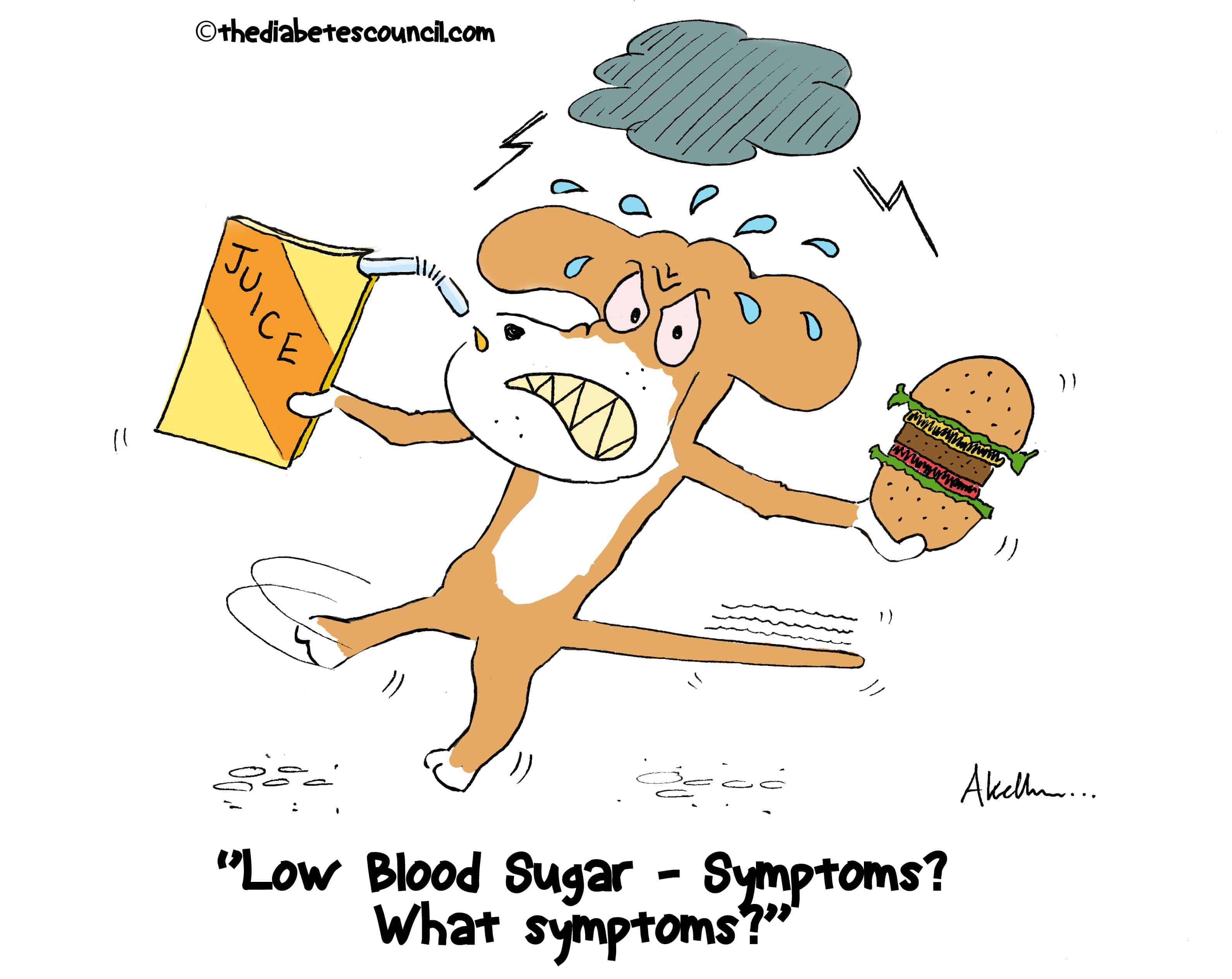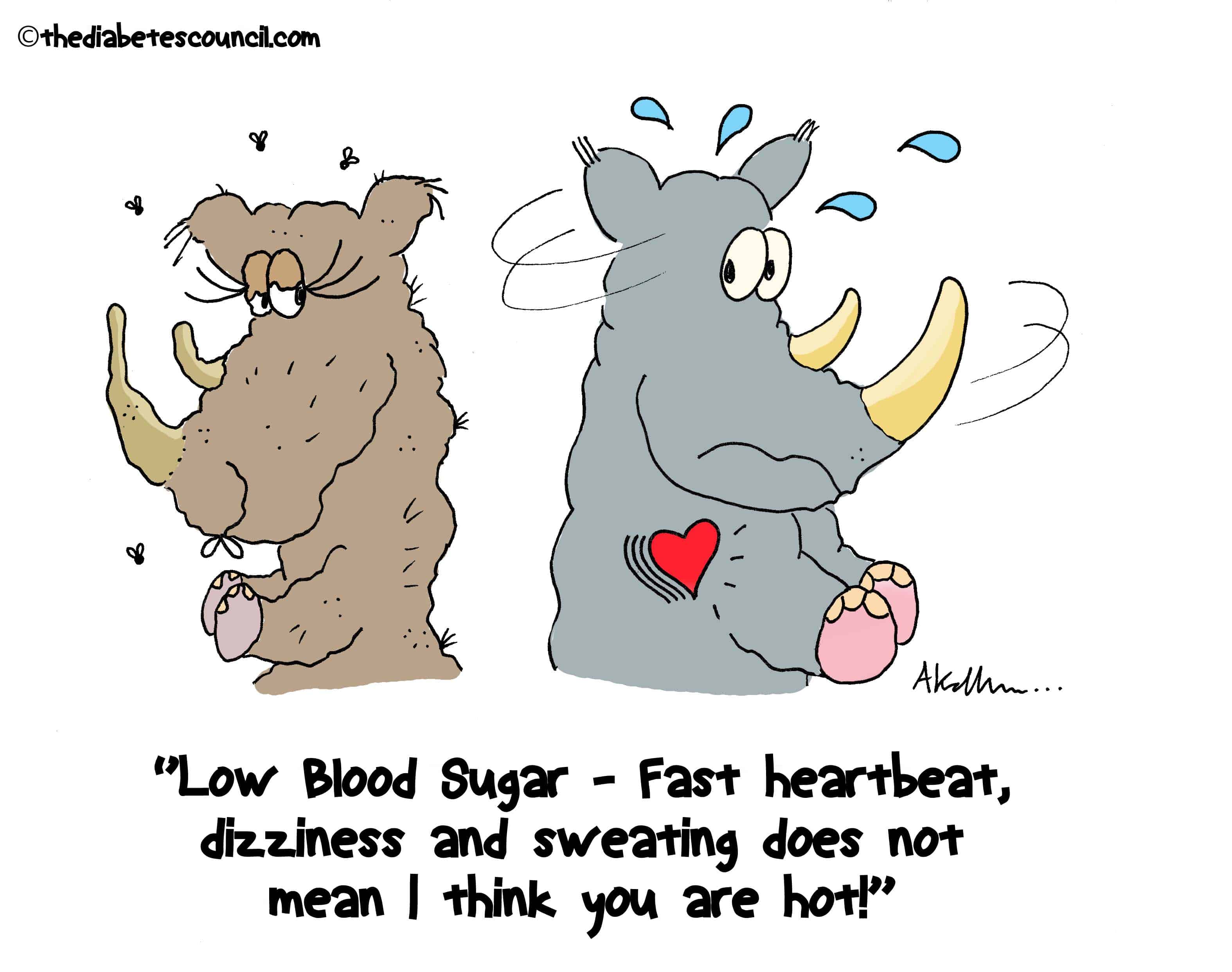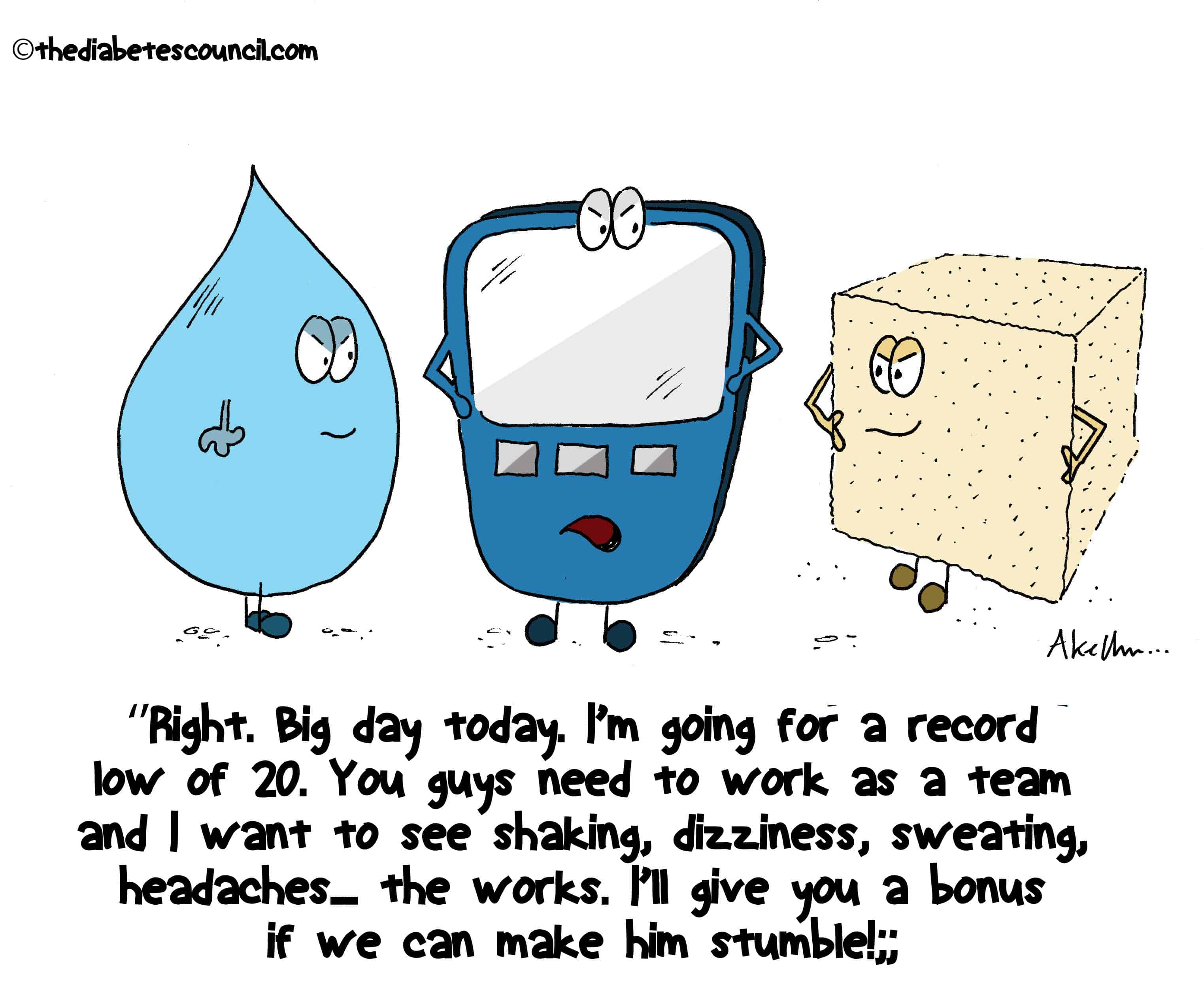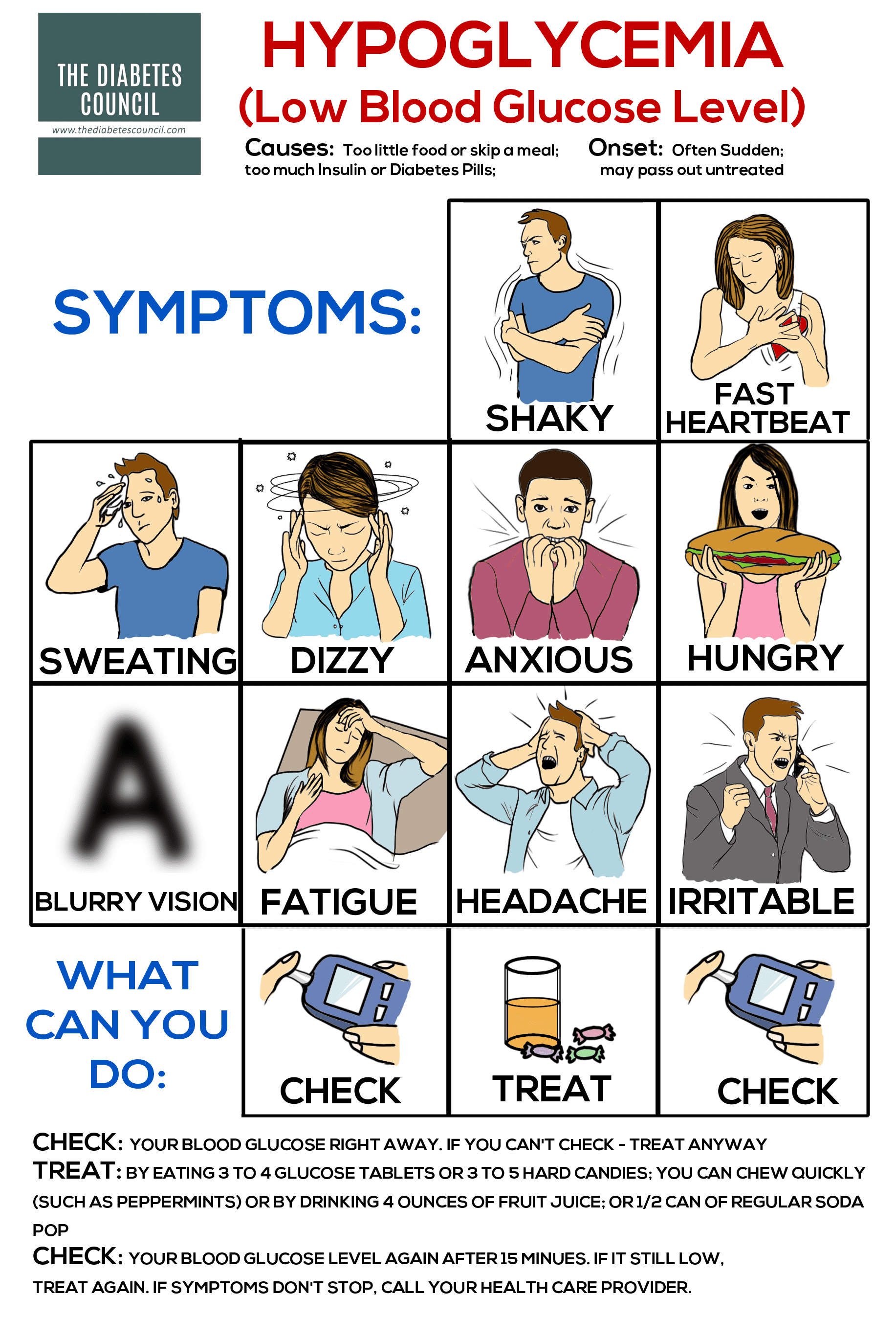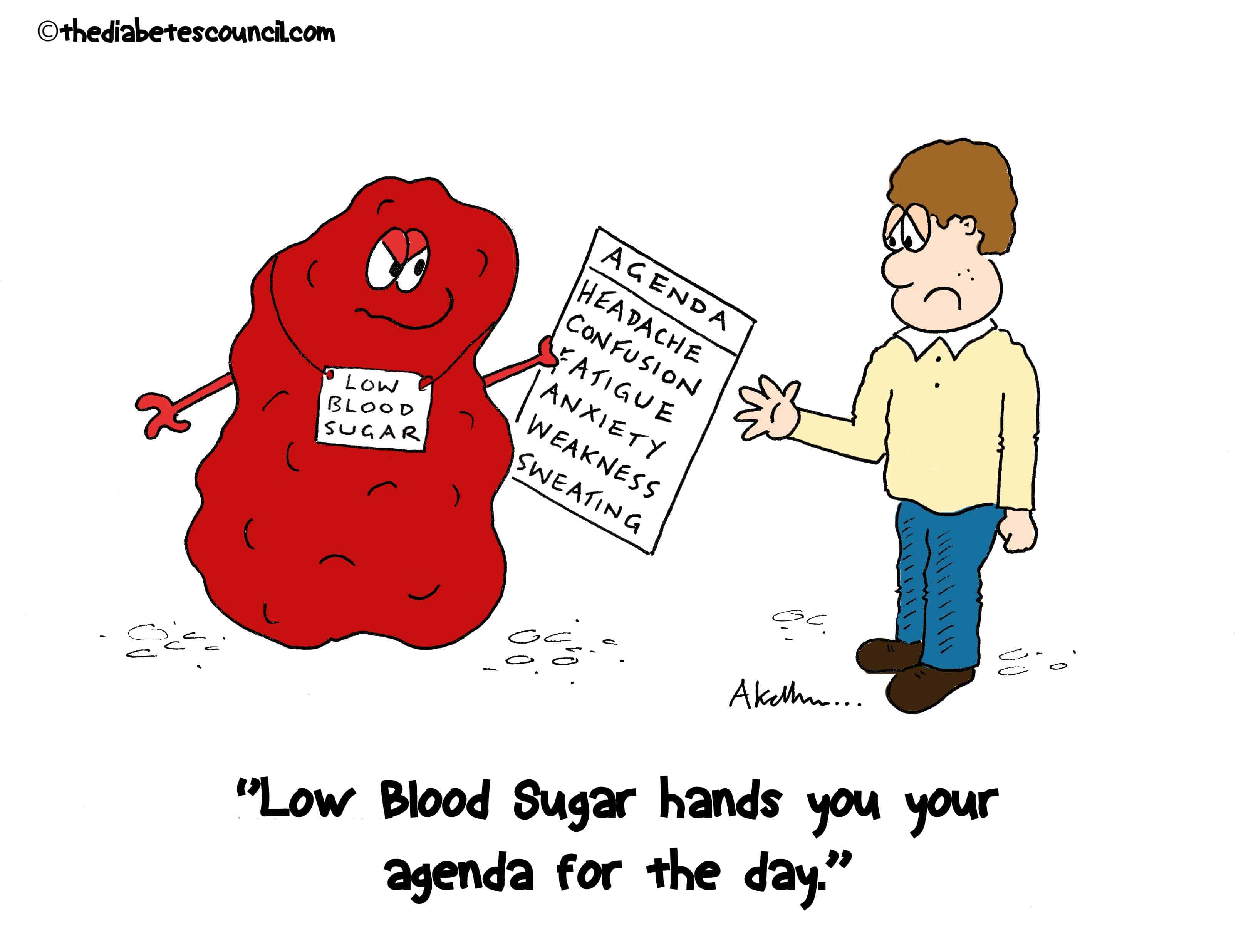
In this article, we will explore what low blood sugar feels like for different people with diabetes. We will look at the symptoms, how they can change over time, and how they are often different from person to person. We will look at planning ahead, and the treatment of hypoglycemia, hereafter referred to as “low blood sugar.”
To get started, patients with Type 1 and Type 2 diabetes were interviewed and asked the question:
Melissa’s story
Melissa is usually gung-ho and ready to go for the day, but when she is handed the low blood sugar agenda, it takes all the wind out of her “cells.” They feel wrinkled up and emaciate.
Here is how Melissa describes her low blood sugars:
I imagine you, (you wrinkly old emaciated cell with no food in you), as a grumpy old man. I scream at you, though I can’t move. No, I won’t take your stifling agenda! I have to work after all. My kids need me to take them to dance class after school.
I’m reluctant to take your agenda, packed with the helplessness that is my poison pill of the day. If I believe those positive self-help type blogs, then I would know that to decide you are happy determines your destination for the day. If you have diabetes, that’s a crock. With diabetes, your low blood sugar determines your agenda, and ultimately what you will be able to do for the day.
When it gets below 70, or dips severely low- it begs and screams to be addressed! Especially if it dips fast, then I’m in trouble. Every cell in my body screams out. If it’s too low, I can’t move to do anything about it! Often I get a little dizzy feeling, and then I know I have to treat.
I will get the shakes so bad that I can’t get a pack of glucose tablets open. That’s when I might as well hang it up for the rest of the day. I know that my concentration level will be off, and I will be so tired. I know this when I continue to stare at the page and read the same thing over and over again. No matter how many times I read it, I can’t seem to comprehend it.”
Now let’s hear from Jim
A few days after I received nutritional education and began watching my carbohydrates more closely, I realized quickly that my insulin dose was too high. On those days, when I went in to work, I quickly went out. I became lucid and unresponsive at one point. I had just recently started work there, and so no one really knew what to do.
I had felt it coming, but I was in the middle of work with my new project, and my boss needed it turned in by the end of the morning. I kept working, thinking my breakfast was still digesting, and it would counteract my low feelings.
I had a slight headache, but attributed it to sinuses. I chose denial of a little weakness and some mild sweating over succumbing to the low blood sugar. I had left my glucometer at home. The drink machine at the office was not working, and I had left my cooler pack with drinks and snacks on the counter in a rush out the door.
It was as if the universe was conspiring against me, and handing me the low blood sugar agenda that I didn’t want or need.
I sat unable to speak or move. I heard the administrative manager calling for EMS. I shook my head, but again I could not speak-confusion taking over. I reached for her desk where she had an unopened soda on one corner, but I was too weak. Too confused…Lights fading…Going down…Goodnight!”
Let’s hear also from Brendon, who had a very difficult time with low blood sugars recently:
When I worked the graveyard shift at the chicken plant, I have no choice but to accept the low blood sugar agenda handed to me nightly.
With a rough swing shift schedule, it was so difficult with type 1 diabetes to work this way. I was in DKA three times in six months while working there. This was shortly after my pump failed and put me in DKA the first time. Then the doc put me back on four shots a day.
After that, it seemed downhill to get my insulin doses regulated with my crazy work schedule. I couldn’t take a break when I needed to. I kept some snacks and things in my pockets, but I was always starting to sweat and feeling confused in the middle of the night. I was finished with my snacks and still having symptoms, with no way to check my blood sugar.
For more informational articles:
The plant operator didn’t understand diabetes, nor did he want to. I was in trouble every night, until I decided to quit the job.
Then I was on unemployment for a while. But at least I could get my diabetes straightened out and get on some kind of a schedule where I didn’t always have this dangerous agenda lurking ahead of me every night of my life.
Thankfully, I could move in with my mother. She cooked meals for me, and supported me. She also was quick to help if I was trending low. When I worked there, it was such a hopeless and depressing feeling to know it would just happen again. I was starting to fear I wasn’t going to get up from one of these lows, and something had to give.
Next, people with diabetes were interviewed and asked, “What are your most common symptoms? How have they changed over the course of your diabetes?
Jenny’s story
That’s the problem. So often I don’t have symptoms of my low blood sugars until it is too late.
My job keeps me busy, and sometimes low blood sugars creep up on me like a thief. I will sometimes have a very slight and mild headache, which is difficult to distinguish between a sinus headache and one from low blood sugar.
I will get the slightest perspiration, but it’s hot and humid where we do the screen printing at work, so it’s hard to tell what’s what. The first few times it happened after I was diagnosed and started on insulin, I didn’t take heed of the slight signs I was having. This resulted in EMS having to come to me at my job, which was extremely embarrassing for me. Now, I’ve learned to keep everything on me. I’ve got quick carbohydrates at all times, including glucose tablets, and I also keep a glucagon pen.
If I start to feel even the least bit ‘off,’ I have my glucometer and check my blood sugar. I’ve learned that sometimes, I need to eat the quick carbohydrates right away, and then check my blood sugar to confirm. Often, if I wait until I check my blood sugar to consume the carbohydrates, I’m too low to treat myself.
So I’ve learned what my lows feel like and how fast they come on, and that has changed the way I react to them. I don’t play, because over time I get less and less of a low blood sugar reaction. I have to be in touch with subtle cues that tell me I’m trending low. Then I have to react with speed before I get the cloudy-headed feeling, the irritability, and the dizziness.
If I don’t get some carbohydrates in me before then, I’ve lost a few friends from yelling at them. What’s worse is, I’m going down for the count and won’t be worth anything the rest of the day.
Now let’s hear from Jessie
My biggest sign of a low blood sugar is that of impending doom. I start to feel a weighted amount of anxiety that is greater than at any other time. I start to shake, and find it hard to concentrate. If I’m feeling hopeless, depressed and anxious about something, I check my blood sugar. I am most always trending low when I feel the nervousness set in.
At other times in my life, I have not felt a thing. I will not feel the least bit tired or off, and I will feel like I have some energy. Then, boom! Out of nowhere it hits me, and I have little time to react. I go straight to confusion, not being able to move, and having big floaters in my field of vision. I’m grateful to my husband when it hits like that. He knows exactly what to do. It’s rather scary.
I’m late for things all of the time because of my diabetes, and low blood sugars. Sometimes I’m afraid people may think I am just using it to get out of things, but it’s really quite severe.
Hope has a milder experience
I have a low blood sugar on occasion. It usually only happens about once a year, and for that I am grateful. It has only gone as low as 58 (mg/dl). I had to treat it with carbohydrates. It started out with a feeling of apprehension, and then I got pretty shaky. I noticed the beads of sweat starting on my forehead.
I had been to my diabetes classes, so I knew exactly what to do, and I had glucose tablets ready in my purse. I took 3 of them, and I waited 15 minutes and checked again. That time it was 80, so I had a snack coming up. I ate that, and then two hours later, I was at 120 (mg/dl).
So far, my few lows haven’t caused me too much of a problem. Maybe it is because I don’t wait too long, and I always keep my glucometer, supplies, and some quick carbohydrates to deal with a low blood sugar.
Tanner’s tale
“I can’t believe what happened the last time I had a low blood sugar. I was sitting in the library at college, and there was a girl sitting next to me at the table studying. I started having my usual signs of low blood sugar. I got sweaty; my heart was beating faster which made me appear nervous all of a sudden.
I started fidgeting in my chair and was a bit confused, trying to remember if I had my glucometer and snacks, and where they were located. I stood up and lost my balance. At that point, I fell into the female student that was working next to me.
By then I was sweating all over, and I was trying to talk, but only slurred words were coming out. I tried to apologize that I fell into her, but I don’t think that came out quite right either.
I was about to get into the pocket in my book bag and get my glucometer, when she jumped up from her chair. Disgusted, she said angrily, ‘Well, I never!’ She took off in a huff before I had a chance to say anything else. Not that I could have said anything anyway. I was in the throes of my low blood sugar, and having trouble moving or talking. I guess she thought I was just all worked up over her, and it offended her somehow. So if you sit next to me in the library, and I start to act a little funny, sweating and looking nervous, it’s not because I think you are hot! If she had waited long enough to see me get my glucometer out to check my blood sugar, she might have thought different of me. Sometimes my diabetes gives the wrong impression.
Donald Ray’s story (Rest in Peace)
I’ll tell you what a low blood sugar is like.
It’s like your blood and the sugar in your body are getting together for a party, and you’re not invited. If the tag team is lucky, they will surely take you down in a drooling, slurring mess.
When I was losing my vision and my home health nurse couldn’t come to draw up my insulin, I used to do it by my knuckles. This caused me quite a few problems as you can imagine, so I had to quit it.
If I drew up to my first knuckle, I could likely sit up straight and talk to you pretty well. If I drew up to my second knuckle, I was slurring my words and likely saying some choice words to you, or calling your mother some names. I fired my share of home health nurses in my day. I kept one once, because he brought me what I wanted, which was Little Debbie cakes. He said he would bring me some to have if I would promise not to draw up my own insulin. That seemed like a fair trade to me.
Then there were those times when I wanted the Dry Dock Seafood buffet, so I went and ate it anyway even though I knew I shouldn’t. Then I drew my insulin up to my last knuckle, which almost had me taking my last breathe. Just before the lights went out, I was feeling my lips and tongue go numb. I had been sweating clean through my shirt. The next thing I remember is waking up in the emergency room after doing this, thinking I will never do it again. The doctors said I had a seizure.
I’ve had Type 1 Diabetes since I was six years old, and they told me I wouldn’t live past age 30 back then. I’ve made it 25 more years than I was supposed to. But I’ve come close to taking myself out on occasion by using some pretty unsafe practices.
As I’m going down for the count, I can think inside my head clearly, but I can’t for the life of me tell someone anything. I get stuck. I can’t really move. If I’m standing up, I’m liable to topple over like a webble-wobble that won’t bounce back. Sometimes my balance is just off like that when I get a low blood sugar. Sometimes my heart beats so fast that I hyperventilate. It’s no fun, and I aim to avoid it from now on.
Contents
What are all the signs and symptoms of low blood sugar?
There is a long list of low blood sugar symptoms, which we have listed below. Some lists overlap symptoms of high blood sugar with symptoms of low blood sugar. That is because some people will have certain symptoms with low blood sugars, while another person with diabetes may experience the same type of symptom with a high blood sugar. Here is a fairly exhaustive list of symptoms of low blood sugar:
- angry
- light-headed
- anxious
- nauseous
- blurred vision
- nervous
- chills
- nightmares
- clammy skin
- sad
- confused
- seizures
- decreased coordination
- shaky
- delirious
- sleepy
- dizziness
- stubborn
- fast heartbeat
- sweaty
- fatigued
- talking or crying in sleep
- headaches
- tingling lips or tongue
- hungry
- tired
- impatient
- unconsciousness
- irritable
- weakness
Universal hypoglycemia “faces”
The “faces” of low blood sugar have been around for a few decades. They are an oldie but a goodie. The faces are universal, and most anyone can look at a picture of the cartoon that is “shaking” and know that it stands for shaking, etc. This is a good thing to put on your refrigerator if you have diabetes, so that someone may be able to look at you sweating, and see that sweating is a possible sign of low blood sugar. Then they may also provide the treatment listed at the bottom of the flyer. It lists the most common symptoms of low blood sugar. There is also a “Faces” flyer for the signs and symptoms of high blood sugar.
Autonomic failure in diabetes
The main thing is that you are able to recognize your own signs and symptoms of low blood sugar. Not everyone experiences all of the symptoms listed above all of the time. Symptoms have a tendency to change over time.
As the natural course of diabetes is played out, the tendency for autonomic symptoms to fade out is a problem. Especially if there are many episodes of low blood sugars in a recent period of time, the person with diabetes may stop feeling many of the symptoms that signal a low blood sugar. If they cannot feel it coming on, they cannot treat it with fast-acting carbohydrates.
This places them at a greater risk of severely low blood sugars, seizure, and sudden death. If the body doesn’t have an appropriate autonomic response to the signs and symptoms of low blood sugar, defense against it is lessened. In one study, the researchers hypothesized that recurrent hypoglycemia or low blood sugars, would result in a “vicious cycle,” where one episode would cause the next to be more severe by virtue of decreased recognition of symptomatology. The researchers concluded that “a single episode of afternoon hypoglycemia results in both elevated glycemic thresholds for autonomic and symptomatic responses to hypoglycemia and impaired physiological defense against hypoglycemia the next morning in IDDM.”1
If you want more information regarding diabetes see below:
I am unable to feel the signs and symptoms of my low blood sugars. What can I do to make sure that my low blood sugar does not get so severe that I need outside help or EMS?
The inability to recognize symptoms of a low blood sugar is called “hypoglycemic unawareness.” Since it is dangerous to have severely low blood sugars, and your body may not be warning you about them, consult with your doctor. If you have insurance that covers it, your doctor can order a Continuous Glucose Monitor or CGM. This will help to alert you when your blood sugar is trending low, so that you may treat it with the appropriate amount of carbohydrates. A CGM can be literally a lifesaver in this situation. If you are unable to get a CGM, make sure to have your doctor order a glucagon pen. Make sure that family and co-workers know the signs and symptoms you may display when you have a low blood sugar, and how to administer glucagon.
I think that I over treat my low blood sugars. What would be the correct treatment for when I drop below 70 (mg/dl)?
15-20 grams of fast-acting carbohydrates is needed. It’s really not the time for a candy bar or a honey bun. It takes a while to digest those foods. Instead, pick one of the following quick-acting carbohydrates to correct your low blood sugar:
- 3-4 glucose tablets
- 4 ounces fruit juice
- 5-6 ounces regular soda, such as cola
- 1 tablespoon of sugar or jelly
- 7-8 lifesavers or similar size hard candies
- 5-6 ounces of milk
- 1 tablespoon of honey
- if unconscious, a glucagon injection pen if available
- 15 gram tube of gel icing from the cake aisle at the grocery store (bystanders can work into the inside of your cheek if you are unconscious after calling 911)
After you have consumed 15 grams of quick-acting carbohydrates, wait 15 minutes, and then recheck your blood sugar. If it is not up over 80 mg/dl, then consume another 15-20 grams of fast-acting carbohydrate and recheck again in 15 minutes. Repeat these steps until blood sugar is over 80 mg/dl. If the person passes out, call 911 first thing to make sure that help is on the way. Bystanders should not try to force feed or pour liquid into the person’s mouth; otherwise it may enter the person’s lungs. While waiting on EMS, you can put the tube of gel icing between the teeth and cheek. Hopefully, enough will be absorbed into the skin of the cheek to revive the person at this point. If not, you will have already called EMS and they will be on the way.
How many carbohydrates should I take in if I plan to exercise to prevent a low blood sugar?
Consult the chart below when deciding how many carbohydrates you need to avoid a low blood sugar during exercise2:
| Exercise Duration & Intensity | <100 mg/dL | 100-180 mg/dL | 180-250 mg/dL |
| < 30 min. at low intensity | Eat 15 g carbohydrate | N/A | N/A |
| 30-60 min. at moderate intensity | Eat 15 g carbohydrate | 100-120: Eat 15 g carbohydrate. 121-180: N/A | N/A |
| 30-60 min. at high intensity | Eat 30 g carbohydrate | Eat 15 g carbohydrate | N/A |
| > 60 minutes at moderate intensity* | Eat 15 g carbohydrate per hour of activity | Eat 15 g of carbohydrate per hour of activity | After 1 hour of activity, eat 15 grams carbohydrate |
Further reading:
Over to you
What is it like and what do you do when life hands you the low blood sugar agenda for the day? Share it in the comments section below. Also share the article with anyone with low blood sugar.
TheDiabetesCouncil Article | Reviewed by Dr. Sergii Vasyliuk MD on June 03, 2020


